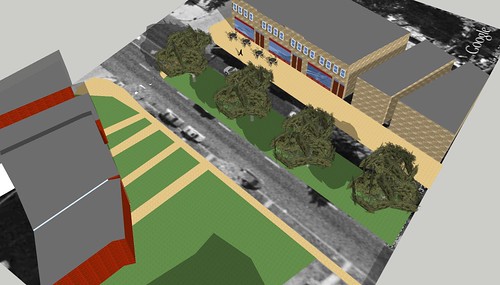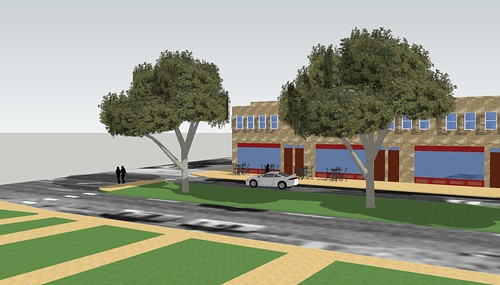The Better Block project in Oak Cliff did just that--made a forgotten little commercial corridor a much better block, if briefly. A team of artists and community activists set about reclaiming a stretch of one-way, car-friendly road that had a bunch of vacant but pedestrian-oriented commercial buildings.
They painted a bicycle lane, created faux-pedestrian lighting, received donations of plants for some on-the-go streetscaping, and even went so far as to install one-day-only "businesses" in each vacant storefront. A flower gallery, cafe, and children's art studio popped up on the stretch overnight. The point was to show what a narrowed, enlivened street that accommodated all modes of traffic (pedestrians, cyclists, and cars) could look like one day of the year so that residents could demand such an environment 365 days a year. The event organizers' wishes soon came true, as city officials soon expressed a desire to make the installation permanent. Several businesses leased the empty spaces immediately afterward as well!
Their fruits of their efforts, under a paltry $1,000 budget, were nothing short of spectacular. Here is a shot of a before (bottom) and after (top) of the bettered block:
You can watch the video of the street's metamorphosis below:
The organizers even left admirers with a "How To" guide for creating a better block in your own city...which is exactly what St. Louis should do. One of the best observations made by the Block Betterers is that the owners of the vacant space essentially get the most up close and personal marketing available. What a great way to generate interest in forgotten commercial districts across the city!
Of course, I got to thinking of where in the city would be most appropriate for such a project. The purpose of the project is to take a stretch of road that is highly visible and highly trafficked and return it to its original pedestrian-oriented function. (Cars are still allowed, albeit on a narrower, safer road).
Initially I thought of Olive Street just west of Taylor in the Central West End. It has many empty storefronts and could truly shine with the Oak Cliff treatment:
However, Olive Street has storefronts that have been vacant and sealed for quite some time. Just the task of getting the owners to remove the boards and make the properties safe for staging might be too much of a hassle. Plus, more importantly, the road is probably far too quiet and off the beaten path to make the same impact as shown above in Dallas. (As a plus, though, the south side of Olive appears to have pedestrian lighting already in place. Yes, I said only the south side. The north side of the street falls within another ward. Sigh. Another plus is that nearby Bowood Farms could donate some trees for streetscaping.)
So after giving it a bit more thought, I think I found the perfect spot.
That's a shot of Gravois Avenue at Victor Street. This stretch has a series of mixed use and commercial buildings not unlike the Dallas road. Gravois is a high-speed road, incredibly visible, and yet, in this strip, is still largely intact.
Imagine the above scene with a two-lane road in place of six. A green bike zone clings to each side of the road; historic street lamps adorn an artificially expanded sidewalk; trees and shrubs soften the industrial grayness of the street. The Dallas team included lots of artists, and Good Citizen Art Gallery, already extant on Gravois, could take the opportunity to make this temporary re-do of its host road something of an outdoor art exhibit. The strip already has a bakery, with Bittersweet Bakery, and a recording studio, Shock City Studios, among other businesses, so the pressure to create fake, one-night-only businesses is lessened. Yet, of course, there are still enough unfilled storefronts to change the dynamic of this part of Gravois from expressway to true urban business district.
So what do you think? Who's willing to put a St. Louis Better Block project together? If you agree with me, and think we should take over a block of St. Louis, let's get started!


























